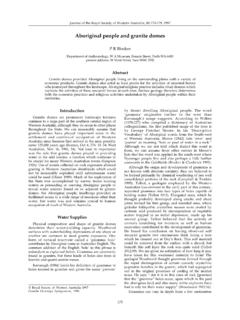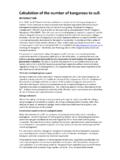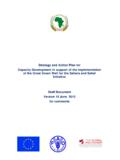Transcription of Assessing the conservation reserve system in the Jarrah ...
1 Journal of the Royal Society of Western Australia, 79(4), December 1996241 Assessing the conservation reserve system in the Jarrah Forest BioregionN L McKenzie1, S D Hopper2, G Wardell-Johnson1,3 & N Gibson11 Science and Information Division, Department of conservation and Land Management, P O Box 51, Wanneroo WA 6065; 2 Kings Park and Botanic Gardens, Fraser Avenue, West Perth WA 6005; 3 present address: Department of Biology, University ofNamibia, Private Bag 13301, Windhoek NamibiaAbstractRecent reviews have assessed the comprehensiveness of the conservation reserve system overthe northern part of the Jarrah Forest Bioregion in terms of vegetation complexes. The complexeswere distinguished in terms of geomorphology and dominant vegetation.
2 The least reservedcomplexes are those of the Darling Scarp, Blackwood Plateau, Collie Coalfields and those withagriculturally desirable maps can be used to estimate the reserved area of each of the Bioregion s vegetationcomplexes or geomorphic units, but there are not enough data on patterns in biodiversity toassess other facets of its adequacy, even in the northern part of the region. A quadrat-basedregional survey is necessary if the representativeness of the area s reserve system is to be assessedfrom an ecosystem perspective. The sampling would need to cover a range of the differentcomponents of the biota (perennial floristics, vertebrates and selected invertebrate taxa).
3 Suchsurveys are time-consuming and expensive. Current studies of rare, restricted and endemic spe-cies, of weed, feral animal and pathogen impacts, and of forest management effects, need tocontinue in recent national assessment of the major gaps in Australia s conservation reserve networksuggests that other Western Australian regions have higher priority for regional survey than theJarrah Forest Bioregion. Seventeen of the State s 26 bioregions have a smaller proportion of theirarea reserved than the Jarrah Forest, and of these, 11 have a more biased reserve system . Shouldwe commit scarce survey resources to the Jarrah Forest Bioregion?
4 IntroductionThe high rainfall part of south-western Australia iscovered by the Darling Botanical District (Beard 1982).This district is made up of the Swan Coastal Plain(Drummond Botanical Sub-district), the northern jarrahforest (Dale Sub-district), the southern Jarrah forest(Menzies Sub-district) and the karri forest (Warren Sub-district).We provide a brief review of the data that are avail-able to assess the coverage of the existing conservationreserve system for the communities indigenous to theDale and Menzies Sub-districts. Together, these two sub-districts form the Jarrah Forest Bioregion (Thackway andCresswell 1995). We then describe and discuss previousassessments of the reserve system in this knowledgeBeside bioclimatic surface models (Nix & Gillison1985), various environmental maps at 1:250,000 scalecover all or most of the bioregion; surface lithology (Wilde & Low 1978, 1980; Wilde& Walker 1982, 1984), landforms and soils (Churchward & McArthur1980; Churchward et al.)
5 1988; Tille & Lantzke1990; Churchward 1992). The 1:250 000 coverageis 90% complete whereas the 1:100 000 coverage isabout 50% complete; R Harper, pers. comm.), and vegetation structure (Beard 1982; Heddle,Loneragan & Havel 1980).At such scales, considerable heterogeneity is averagedwithin each are also 1:25 000 Aerial Photographic Interpre-tation (API) maps of tree-canopy floristics, mapped at 1:15 800 and ground-truthed along tracks and roads (F JBradshaw et al., unpublished). They were produced bythe Forests Department during the 1950s and 1960s, andcover virtually all the forested parts of the Bioregionexcept; parts of the far northern end (north of 31 45' S,although Julimar State Forest was mapped), al-though the mapping has recently been extended, most of the eastern edge between 32 00' S and 34 30' S, although some parts, such as Dryandra StateForest, are covered by 1.
6 15 800 scale Mallet Clas-sification vegetation maps made during the1930s, and the far south-eastern corner, east of 117 40' of the areas not covered at this scale are re-served for nature conservation and mapped at anequivalent scale, or are private land that is mesic bioregions of south-western Australia areremote from their eastern Australian counterparts, beingisolated by 2000 km of the semi-arid and arid environ-Journal of the Royal Society of Western Australia, 79:241 248, 1996 Symposium on the Design of Reserves forNature conservation in South-western Australia Royal Society of Western Australia 1996242 Journal of the Royal Society of Western Australia, 79(4), December 1996ments that comprise districts such as the Nullarbor andthe Great Victoria Desert.
7 They contain many endemicspecies that are relicts from previously wetter and lessseasonal climatic periods. Examples from the Jarrah For-est Bioregion include the frogs Geocrinia alba and , and the eucalypts Yarri (Eucalyptus patens), and E. virginia (Wardell-Johnston et al. in press).Their vegetation and floristics have been reviewed byHavel (1975, 1989), Wardell-Johnson et al. (1996) andWardell-Johnson & Horwitz (1996), and the rare flora byKelly et al. (1990), while knowledge of the fauna hasbeen reviewed by Wardell-Johnson & Nichols (1991),Abbott & Christensen (1994) and Wardell-Johnson &Horwitz (1996).Several factors, including the isolation, the small areaand previous climate changes, have lowered diversity inthe larger indigenous vertebrates of the south-westernforests, but the invertebrates and small vertebrates arerich in species (Wardell-Johnson & Horwitz, 1996).
8 Insitu speciation is real in the south-west, for the fauna aswell as the flora; Havel and others have demonstrated arich mosaic of landforms, soils and floristic variation inthe Jarrah forest despite the area s great structural ho-mogeneity in vegetation, and Wardell-Johnson & Rob-erts (1993) concluded that the rich but fine-scale varia-tion in soil and landscape properties maintains barriersbetween closely related frog species. A recently discov-ered frog, endemic to the Bioregion, is the most geo-graphically restricted frog known from mainland Aus-tralia (Roberts et al., 1997).It is clear that many scales should be considered inany discussion of conservation in the Jarrah ForestBioregion.
9 However, coordinated work on the distribu-tion and biology of the naturally rare and of the re-stricted and endemic flora of the Bioregion has com-menced only in the last decade, and most studies havefocused on the central and northern parts of thebioregion. Systematically-gathered data are still too frag-mentary to reveal their general patterns of studies of fauna have concentrated onvulnerable species, especially mammals that have be-come either extinct or rare outside the forests, wood-lands and shrublands of the Darling District since Euro-pean settlement ( Dasyurus geoffroii, Myrmecobiusfasciatus, Bettongia penicillata, Macropus eugenii andPseudocheirus occidentalis; Burbidge & McKenzie 1989).
10 The numbat study reported by Friend & Thomas (1995)is a good example. The first three species are now thesubject of detailed management programs ( Orell &Morris 1994; Start et al. 1995). Considerable research hasalso been carried out on Macropus eugenii, Pseudocheirusoccidentalis and Isoodon obesulus ( P de Torres, perscomm.) Detailed information has also been collected onthe distribution and habitat requirements of some rarefrogs ( Geocrinia alba and G. vitellina), reptiles ( delli) and birds ( Atrichornis clamosus). Whilethe critical requirements of some vulnerable vertebratesare still unknown ( Macropus irma and Setonixbrachyurus), research programs are now in-place.



